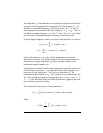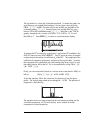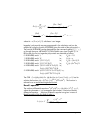
Page 16-47
Properties of the Fourier transform
Linearity: If a and b are constants, and f and g functions, then F{a⋅f + b⋅g} = a
F{f }+ b F{g}.
Transformation of partial derivatives. Let u = u(x,t). If the Fourier transform
transforms the variable x, then
F{∂u/∂x} = iω F{u},
F{∂
2
u/∂x
2
} = -ω
2
F{u},
F{∂u/∂t} = ∂F{u}/∂t, F{∂
2
u/∂t
2
} = ∂
2
F{u}/∂t
2
Convolution: For Fourier transform applications, the operation of convolution is
defined as
The following property holds for convolution:
F{f*g} = F{f}⋅F{g}.
Fast Fourier Transform (FFT)
The Fast Fourier Transform is a computer algorithm by which one can calculate
very efficiently a discrete Fourier transform (DFT). This algorithm has
applications in the analysis of different types of time-dependent signals, from
turbulence measurements to communication signals.
The discrete Fourier transform of a sequence of data values {x
j
}, j = 0, 1, 2, …,
n-1, is a new finite sequence {X
k
}, defined as
The direct calculation of the sequence X
k
involves n
2
products, which would
involve enormous amounts of computer (or calculator) time particularly for large
values of n. The Fast Fourier Transform reduces the number of operations to the
order of n⋅log
2
n. For example, for n = 100, the FFT requires about 664
operations, while the direct calculation would require 10,000 operations. Thus,
∫
⋅⋅−⋅= .)()(
2
1
))(*(
ξξξ
π
dgxfxgf
∑
−
=
−=⋅−⋅=
1
0
1,...,2,1,0),/2exp(
1
n
j
jk
nknkjix
n
X
π


















